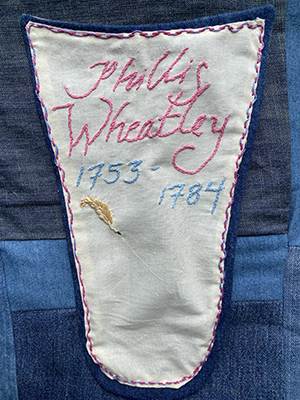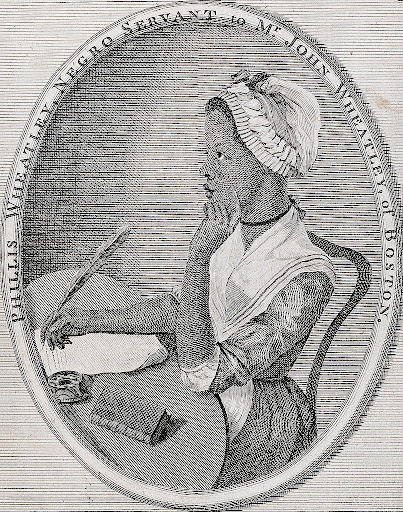Phillis Wheatley
 Mary Benyamin ’25
Mary Benyamin ’25
A scared seven year old girl was kidnapped from her home in Gambia and somehow survived the brutal seven week transAtlantic voyage from West Africa to New England. Confused and not speaking the language, she was sold in 1761 to John Wheatley, a wealthy tailor to founding father John Hancock and other Boston notables. He named her after the ship she arrived on “the Phillis”. She was bought to be a “companion” to his wife Susanna, to fetch her sewing basket, thread her needles, and retrieve her dropped thimble. But when his daughter Mary noticed Phillis drawing letter-like images on the walls, she decided to teach her how to read and write English. In less than two years, she not only mastered the language, but also began to study Latin, Greek, astronomy and geography. At the age of 13 she wrote her first poem and then traveled to England to have her collection published in 1773. There, her writing was admired by Ben Franklin and the British elites. In a world that deemed her gender and ethnicity to be inappropriate for writing poetry, she defied convention. Soon after her return to Boston, the Wheatleys freed her. In one of her poems, “On Being Brought from Africa to America,” she advocates that personhood is not determined by skin color by writing, “Some view our sable race with scornful eye, / ‘Their colour is a diabolic die.’” Reasoning with her newly taught Christian values she censured the mistreatment of African people who “May be refin’d and join th’ angelic train.” Her powerful message used religion to argue that people of color are equal to Whites in God’s eyes.
While ardently supporting the colonists during the American Revolution, Wheatley believed that if the rebels truly wanted to create a path to freedom, they had to eradicate slavery. She wrote eloquent letters to ministers and other figures arguing the importance of liberty and independence. Massachusetts became the first state to abolish slavery in 1783. George Washington himself praised her for her support and invited her to his headquarters in Cambridge, MA.

Today, Phillis Wheatley is celebrated as the first African American (and at that time only the third American woman) to publish a book of poems. Even if it took the leading white men of the 18th century to “legitimize” her work, it has been Black women who have kept her legacy alive. According to the New York Times: “In 1932, the educator Mary Church Terrell created a historical pageant about Wheatley’s life, as part of the bicentennial of Washington’s birth. In 1949, the writer Shirley Graham Du Bois published an influential young-adult biography, “The Story of Phillis Wheatley.” Since 1973, a group of prominent Black women writers have gathered to mark the bicentennial of Wheatley’s book.
In her new book “Reading Pleasures: Everyday Black Living in Early America,” Tara A. Bynum, assistant professor of English and African American Studies at the University of Iowa, discusses Wheatley’s long correspondence with her “friend & Sister” Obour Tanner, who may have arrived in Boston on the same ship. “I’ve asked various audiences who they think of when I say the words ‘the Revolutionary War,’” Bynum said. “They almost never think of two Black women. Yet these are two Black women who are having to navigate the war that brings forth the founding.”